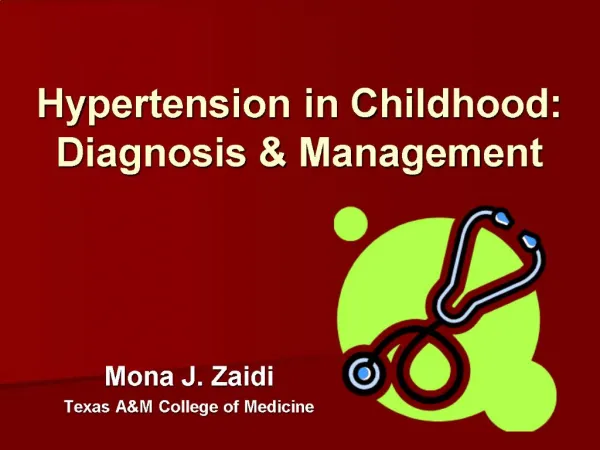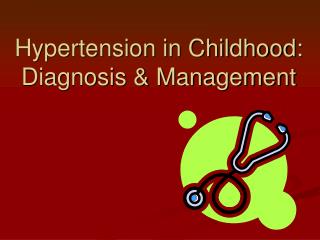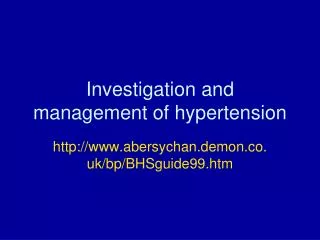Diagnosis and management of Hypertension
Diagnosis and management of Hypertension. Dr. Kauser Usman (MD) Associate Professor Department of Medicine King George’s Medical University, Lucknow.
Share Presentation
Embed Code
Link
Download Presentation
- blockers
- 5 mg
- angiotensin ii
- receptor blockers
- systolic blood pressure
- systolic blood pressure sbp

fwilkinson + Follow
Download Presentation
Diagnosis and management of Hypertension
An Image/Link below is provided (as is) to download presentation Download Policy: Content on the Website is provided to you AS IS for your information and personal use and may not be sold / licensed / shared on other websites without getting consent from its author. Content is provided to you AS IS for your information and personal use only. Download presentation by click this link. While downloading, if for some reason you are not able to download a presentation, the publisher may have deleted the file from their server. During download, if you can't get a presentation, the file might be deleted by the publisher.
Presentation Transcript
- Diagnosis and management of Hypertension Dr. KauserUsman (MD) Associate Professor Department of Medicine King George’s Medical University, Lucknow
- Hypertension is defined as systolic blood pressure (SBP) of 140 mmHg or greater, diastolic blood pressure (DBP) of90 mmHg or greater, or taking antihypertensive medication. VI JNC, 1997
- Types of hypertension • Essential hypertension • 95% • No underlying cause • Secondary hypertension • Underlying cause
- Causes of Secondary Hypertension • Renal • Parenchymal • Vascular • Others • Endocrine • Miscellaneous • Unknown
- Classification
- Blood Pressure Classification
- Incidence in India • 25% of urban population and 10 % of rural population suffer from hypertension • 70% of all hypertensive patients are stage I hypertension • 12% of all hypertensive suffer from isolated systolic hypertension
- Who are at risk ?
- Hypertension: Predisposing factors • Advancing Age • Sex (men and postmenopausal women) • Family history of cardiovascular disease • Sedentary life style & psycho-social stress • Smoking ,High cholesterol diet, Low fruit consumption • Obesity & wt. gain • Co-existing disorders such as diabetes, and hyperlipidaemia • High intake of alcohol
- Haemodynamic Pattern in Hypertension Young : BP = CO X TPR Elderly : BP = CO X TPR
- Aetiology of Systemic Hypertension Secondary HTN (05%) Continue…
- Aetiology of Systemic Hypertension Others • Coarctation of the aorta • Pregnancy Induced HTN (Pre-eclampsia) • Sleep Apnea Syndrome.
- Why to treat ?
- Diseases Attributable to Hypertension Left Ventricular Hypertrophy Heart Failure Gangrene of the Lower Extremities Myocardial Infarction Coronary Heart Disease Aortic Aneurym HYPERTENSION Hypertensive encephalopathy Blindness Cerebral Hemorrhage Chronic Kidney Failure Stroke Preeclampsia/Eclampsia Adapted from Dustan HP et al. Arch Intern Med. 1996; 156: 1926-1935
- Target Organ Damage • Heart • Left ventricular hypertrophy • Angina or myocardial infarction • Heart failure • Brain • Stroke or transient ischemic attack • Chronic kidney disease • Peripheral arterial disease • Retinopathy
- CVD Risk • The BP relationship to risk of CVD is continuous, consistent, and independent of other risk factors. • Prehypertension signals the need for increased education to reduce BP in order to prevent hypertension.
- Diagnosis
- Clinical manifestations • No specific complains or manifestations other than elevated systolic and/or diastolic BP (Silent Killer) • Morning occipital headache • Dizziness • Fatigue • In severe hypertension, epistaxis or blurred vision
- Self-Measurement of BP • Provides information on: • Response to antihypertensive therapy • Improving adherence with therapy • Evaluating white-coat HTN • Home measurement of >135/85 mmHg is generally considered to be hypertensive. • Home measurement devices should be checked regularly.
- Measuring Blood Pressure • Patient seated quietly for at least 5minutes in a chair, with feet on the floor and arm supported at heart level • An appropriate-sized cuff (cuff bladder encircling at least 80% of the arm) • At least 2 measurements Continue…
- Measuring Blood Pressure • Systolic Blood Pressure is the point at which the first of 2 or more sounds is heard • Diastolic Blood Pressure is the point of disappearance of the sounds (Korotkoff 5th) Continue…
- Measuring Blood Pressure • Ambulatory BP Monitoring - information about BP during daily activities and sleep. • Correlates better than office measurements with target-organ injury. Continue…
- Laboratory Tests • Routine Tests • Electrocardiogram • Urinalysis • Blood glucose, • Serum potassium, creatinine, or the corresponding estimated GFR, and calcium • Lipid profile, after 9- to 12-hour fast, that includes high-density and low-density lipoprotein cholesterol, and triglycerides • Optional tests • Measurement of urinary albumin excretion or albumin/creatinine ratio • More extensive testing for identifiable causes is not generally indicated unless BP control is not achieved
- How to treat ?
- Treatment Overview • Goals of therapy • Lifestyle modification • Pharmacologic treatment • Algorithm for treatment of hypertension • Follow up and monitoring
- Goals of Therapy • Reduce Cardiac and renal morbidity and mortality. • Treat to BP
- Non pharmacological Treatment of hypertension DASH diet Regular exercise Loose weight , if obese Reduce salt and high fat diets Avoid harmful habits ,smoking ,alcohal
- Life style modifications • Lose weight, if overweight • Increase physical activity • Reduce salt intake • Stop smoking • Limit intake of foods rich in fats and cholesterol • increase consumption of fruits and vegetables • Limit alcohol intake
- Lifestyle Modification
- Antihypertensive Drugs AT1 receptor Continue…. ARB
- Drug therapy for hypertension Class of drugExample Initiating dose Usual maintenance dose Diuretics Hydrochlorothiazide 12.5 mg o.d. 12.5-25 mg o.d. -blockers Atenolol 25-50 mg o.d. 50-100 mg o.d. Calcium Amlodipine 2.5-5 mg o.d. 5-10 mg o.d. channel blockers -blockers prazosin 2.5 mg o.d 2.5-10mg o.d. ACE- inhibitors ramipril 1.25-5 mg o.d. 5-20 mg o.d. Angiotensin-II Losartan 25-50 mg o.d. 50-100 mg o.d. receptor blockers
- Diuretics Example:Hydrochlorothiazide • Act by decreasing blood volume and cardiac output • Decrease peripheral resistance during chronic therapy • Drugs of choice in elderly hypertensives Side effects- • Hypokalaemia • Hyponatraemia • Hyperlipidaemia • Hyperuricaemia (hence contraindicated in gout) • Hyperglycaemia (hence not safe in diabetes) • Not safe in renal and hepatic insufficiency
- Beta blockers Example:Atenolol, Metoprolol, nebivolol, • Block b1 receptors on the heart • Block b2 receptors on kidney and inhibit release of renin • Decrease rate and force of contraction and thus reduce cardiac output • Drugs of choice in patients with co-existent coronary heart disease Side effects- • lethargy, impotency, bradycardia • Not safe in patients with co-existing asthma and diabetes • Have an adverse effect on the lipid profile
- Calcium channel blockers Example:Amlodipine • Block entry of calcium through calcium channels • Cause vasodilation and reduce peripheral resistance • Drugs of choice in elderly hypertensives and those with co-existing asthma • Neutral effect on glucose and lipid levels Side effects Flushing, headache, Pedal edema
- ACE inhibitors Example:Ramipril, Lisinopril, Enalapril • Inhibit ACE and formation of angiotensin II and block its effects • Drugs of choice in co-existent diabetes mellitus, Heart failure Side effects- dry cough, hypotension, angioedema
- Angiotensin II receptor blockers Example:Losartan • Block the angiotensin II receptor and inhibit effects of angiotensin II • Drugs of choice in patients with co-existing diabetes mellitus Side effects- safer than ACEI, hypotension,
- Alpha blockers Example:prazosin • Block a-1 receptors and cause vasodilation • Reduce peripheral resistance and venous return • Exert beneficial effects on lipids and insulin sensitivity • Drugs of choice in patients with co-existing BPH Side effects- Postural hypotension,
- Antihypertensive therapy:Side-effects and Contraindications Class of drugs Main side-effects Contraindications/ Special Precautions Diuretics Electrolyte imbalance, Hypersensitivity, Anuria(e.g. Hydrochloro- total and LDL cholesterol thiazide) levels, ¯ HDL cholesterol levels, glucose levels, uric acid levels b-blockers Impotence, Bradycardia, (e.g. Atenolol) Fatigue Bradycardia, Conduction disturbances, Diabetes, Asthma, Severe cardiac failure
- Without Compelling Indications With Compelling Indications Drug(s) for the compelling indications Other antihypertensive drugs (diuretics, ACEI, ARB, BB, CCB) as needed. Stage 1 Hypertension(SBP 140–159 or DBP 90–99 mmHg) Thiazide-type diuretics for most. May consider ACEI, ARB, BB, CCB, or combination. Stage 2 Hypertension(SBP >160 or DBP >100 mmHg) 2-drug combination for most (usually thiazide-type diuretic and ACEI, or ARB, or BB, or CCB) Not at Goal Blood Pressure Optimize dosages or add additional drugs until goal blood pressure is achieved.Consider consultation with hypertension specialist. Algorithm for Treatment of Hypertension Lifestyle Modifications Not at Goal Blood Pressure (
- Choice of Drug Condition Preferred drugs Other drugs Drugs to be that can be used avoided Asthma Calcium channel a-blockers/Angiotensin-II b-blockers blockers receptor blockers/Diuretics/ ACE-inhibitors Diabetes a-blockers/ACE Calcium channel blockers Diuretics/mellitus inhibitors/ b-blockers Angiotensin-II receptor blockers High cholesterol a-blockers ACE inhibitors/ A-II b-blockers/levels receptor blockers/ Calcium Diuretics channel blockers Elderly patients Calcium channel -blockers/ACE- (above 60 years) blockers/Diuretics inhibitors/Angiotensin-II receptor blockers/- blockers BPH a-blockers b-blockers/ ACE inhibitors/ Angiotensin-II receptor blockers/ Diuretics/ Calcium channel blockers
- Antihypertensive therapy: Side-effects and Contraindications (Contd.) Class of drug Main side-effects Contraindications/ Special Precautions Calcium channel blockers Pedal edema, Headache Non-dihydropyridine(e.g. Amlodipine, CCBs (e.gdiltiazem)– Diltiazem) Hypersensitivity,Bradycardia, Conduction disturbances, CHF, LV dysfunction. a-blockers Postural hypotension Hypersensitivity(e.g. prazosin) ACE-inhibitors Cough, Hypotension, Hypersensitivity, Pregnancy,(e.g. Lisinopril) Angioneurotic edema Bilateral renal artery stenosis Angiotensin-II receptor Headache, Dizziness Hypersensitivity, Pregnancy,blockers (e.g. Losartan) Bilateral renal artery stenosis
- Condition Pregnancy Coronary heart disease Congestive heart failure Preferred Drugs Nifedipine, labetalol, hydralazine, beta-blockers, methyldopa, prazosin Beta-blockers, ACE inhibitors, Calcium channel blockers ACE inhibitors,beta-blockers 1999 WHO-ISH guidelines
- Causes of Resistant Hypertension • Improper BP measurement • Excess sodium intake • Inadequate diuretic therapy • Medication • Inadequate doses • Drug actions and interactions (e.g., (NSAIDs), illicit drugs, sympathomimetics, OCP) • Over-the-counter drugs and some herbal supplements • Excess alcohol intake • Identifiable causes of HTN
- take home message -------------- • Hypertension is a major cause of morbidity and mortality, and needs to be treated • It is an extremely common condition; however it is still under-diagnosed and undertreated • Hypertension is easy to diagnose and easy to treat • Aim of the management is to save the target organ from the deleterious effect • Besides pharmacology we have other choices and one has to be acquainted with that choice • Life style modification should always be encouraged in all Hypertensive patients
- Any questions?
- Que 1) Life style intervention for management of hypertension includes all except: • Regular aerobic activity 30 min /day • Salt intake to 25k/m2 • Diets rich in fruits and vegetables and restricted content of saturated fats • Moderation of alcohol consumption
- Que 2) Hypertension management is helpful in the prevention of all except: • Coronary heart disease • Heart failure • Chronic kidney disease • Deep venous thrombosis • Cerebrovascular disease
- Que 3) Isolated systolic hypertension is common in: • Young • Elderly • Pregnancy • Blacks
- Que 4) Antihypertensive agent recommended for the protection of cardiovascular diseases is: • Calcium channel blockers • Diuretics • ACE inhibitors • Alpha antagonists • Central sympatholytic
- Que 5) Angiotensin Receptor Blockers play Reno protective effect through all except: • Decreasing proteinuria • Decreasing intraglomerular pressure • Preventing endothelial dysfunction • Inhibiting conversion of angiotensin-I to angiotensin –II • Blocking the angiotesin mediated renal remodelling Load More .

Management of hypertension
Management of hypertension. By Dr. Sajid Hussain. objectives. Recall the etiology of hypertension. List the major classes of antihypertensive drugs. Name at least two drugs of each group. Describe the mechanism of action of these drug groups.
694 views • 17 slides

Management of hypertension
Management of hypertension. Dr. Sadananda. Grade 1 hypertension Grade 2 Grade 3 Isolated systolic hypertension Grade 1 Grade 2. 140-159 / 90-99 160-179 / 100-109 >180 / >110 140-159 / <90 > 160 / <90. BHS Classification of blood pressure levels.
555 views • 18 slides

Hypertension in Childhood: Diagnosis Management
Measuring BP in Children. Children >3 years oldPreferred method: Auscultation with appropriate size cuffBP tables include 50th, 90th, 95th, and 99th percentiles by gender, age, and height (compiled by NHBPEP Task Forces)Confirm an elevated BP on at least 2 additional visitsConsider ABPM (por
395 views • 19 slides

Hypertension: diagnosis and management
Objectives. Review the prevalence of hypertension and its importance as a cardiovascular risk factorDescribe criteria for hypertension and steps in its initial managementReview medications used for the management of hypertensionDiscuss treatment strategies based on case discussions. Prevalence
407 views • 39 slides

Diagnosis and management of PUD
Diagnosis and management of PUD. Ermias (MD). History. Abdominal pain (epigatric burn) Common for DU, GU, NUD 10% present with complications with out antecedent pain, eg after NSAID DU – 90min-3hr after meal, past midnight, - relieve with food, antacids
522 views • 20 slides

Management of hypertension
Management of hypertension. What is hypertension?. The heart pumps blood to various parts of the body As blood passes through the blood vessels or arteries it pushes against the walls of the arteries. This is called blood pressure.
519 views • 20 slides

Management of Hypertension
Management of Hypertension. Ghada A Bawazeer. MSc, Pharm.D ., BCPS Ibrahim Sales, Pharm.D . Assistant Professors- Clinical Pharmacy Dept College of Pharmacy Sept. 2013. Background. Most diagnoses occurring between the third and fifth decades of life.
2.95k views • 122 slides

Treatment-Resistant Hypertension: Diagnosis and Management
Treatment-Resistant Hypertension: Diagnosis and Management. Power Over Pressure www.poweroverpressure.com. A particularly complex clinical challenge. Blood pressure (BP) that remains above goal, in spite of… . Treatment-resistant hypertension is defined as: 1,2.
475 views • 23 slides

Treatment-Resistant Hypertension: Diagnosis and Management
Treatment-Resistant Hypertension: Diagnosis and Management. Power Over Pressure www.poweroverpressure.com. Not all patients with uncontrolled hypertension are treatment resistant. Uncontrolled Hypertension. Includes patients who lack blood pressure (BP) control for any reason: 1
490 views • 20 slides

Management of Hypertension
Management of Hypertension. Dr Asso Amin General Internal Medicine and Elderly Physician. What is hypertension. Definition BHS/ ISH/ WHO/ ESH. Prevalence. Survey in England adult above 16 years, 42% men and 33% women were hypertensive * >50% of those above 65
1.5k views • 56 slides

Management of Hypertension
Management of Hypertension. Laura Fitzpatrick, MD, MPH Intern Academics Friday the 13 th , August 2004. Background. The JNC VII guidelines are issued periodically from the National Heart, Lung, and Blood Institute. (NHLBI)
599 views • 47 slides

VA/DoD Clinical Practice Guideline for the Diagnosis and Management of Hypertension
VA/DoD Clinical Practice Guideline for the Diagnosis and Management of Hypertension. US Army Medical Command Quality Management Department Office of Evidence-Based Practice Fort Sam Houston, TX 78248. VA/DoD Guideline Purpose.
576 views • 18 slides

Hypertension in Childhood: Diagnosis & Management
Hypertension in Childhood: Diagnosis & Management. Measuring BP in Children. Children >3 years old Preferred method: Auscultation with appropriate size cuff BP tables include 50 th , 90 th , 95 th , and 99 th percentiles by gender, age, and height (compiled by NHBPEP Task Forces)
346 views • 17 slides

Diagnosis and Management of Shock
Diagnosis and Management of Shock. Dr. Anas Khan Consultant, EM MBBS, MHA, ArBEM 428 C2 notes. Objectives. Identify the 4 main categories of shock. Discuss the goals of resuscitation in shock. Summarize the general principles of shock management.
903 views • 28 slides

Hypertension I Diagnosis, causes
Hypertension I Diagnosis, causes. Mean systolic and diastolic blood pressure by age for men and women. Hypertension 1995. Definition of hypertension.
909 views • 46 slides

Diagnosis and Management of Dementia
Michael Mistric, PhD, RN, FNP, BC Nurse Practitioner Michael E. DeBakey VA Medical Center. Diagnosis and Management of Dementia. Objectives. Describe the demographics associated with Alzheimer’s dementia Describe the clinical features of Alzheimer’s dementia
1.07k views • 61 slides

Investigation and management of hypertension
Investigation and management of hypertension. http://www.abersychan.demon.co.uk/bp/BHSguide99.htm. Why detect and treat?. Most commonly HT is a risk factor for cardiovascular disease, like smoking, DM, lipids. Stroke, LVF, renal failure, MI Less commonly A medical emergency.
447 views • 19 slides

DIAGNOSIS AND MANAGEMENT
DIAGNOSIS AND MANAGEMENT. SALIVARY GLAND PATHOLOGY. DISTRIBUTION OF MINOR SALIVARY GLANDS. Palate 60% Tongue 10% Lips 10% Cheeks 10% Retromolar 10%. TONGUE GLANDS (LINGUAL). Inferior apical—glands of Blandin Nuhn (mucous secretion) Taste buds—vonEbner’s glands (serous secretion)
1.09k views • 70 slides

Management of Hypertension
Management of Hypertension. Introduction to Primary Care: a course of the Center of Post Graduate Studies i n FM. PO Box 27121 – Riyadh 11417 Tel: 4912326 – Fax: 4970847. 1. Objectives. to discuss the importance of hypertension in FP
1.55k views • 33 slides

Diagnosis and Management of ADHD
Diagnosis and Management of ADHD. ADHD.
457 views • 25 slides

Diagnosis and Management of Schizophrenia
Diagnosis and Management of Schizophrenia. Stephen R. Marder, M.D. Professor and Director, Section on Psychosis Semel Institute for Neuroscience at UCLA VA Desert Pacific Mental Illness Research, Education, and Clinical Center. Diagnosis and Management of Schizophrenia.
458 views • 15 slides

Diagnosis and Management of Abnormal
Diagnosis and Management of Abnormal. Professor Hassan Nasrat Chairman Department of Obstetrics and Gynecology. Pattern of Normal Labour.
541 views • 41 slides
























